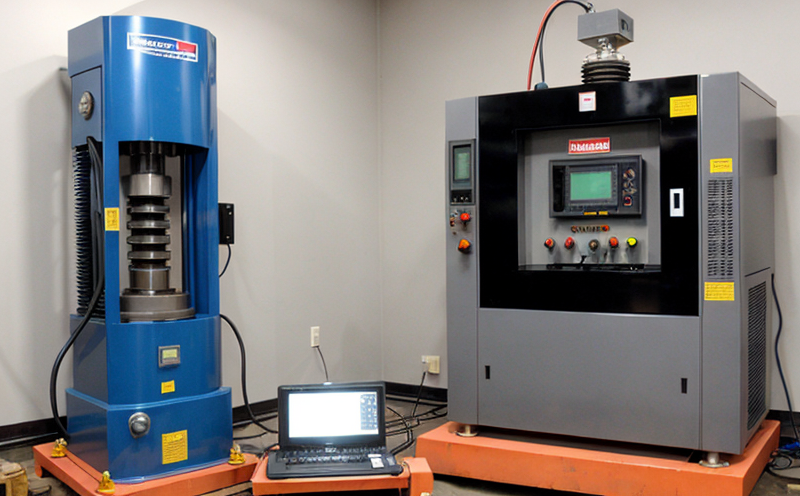DIN EN 60068 2 64 Vibration Testing in Germany
Understanding the robustness and reliability of electronic devices is paramount in ensuring their successful deployment. DIN EN 60068 2-64 provides a standardized approach to assessing mechanical vibration resistance, which is critical for electronics that must withstand harsh environmental conditions. This test is particularly important for sectors like automotive, aerospace, telecommunications, and medical equipment, where components are exposed to significant shock and vibration during operation.
The scope of DIN EN 60068 2-64 encompasses the evaluation of products under controlled vibration environments that simulate real-world operating conditions. This includes both sine wave and random vibration tests, which help determine if a product can operate safely within specified limits without failure or degradation. The test is conducted in accordance with international standards to ensure consistency and comparability across different jurisdictions.
The methodology for conducting DIN EN 60068 2-64 involves subjecting the specimen to controlled vibration conditions that simulate potential real-world exposure scenarios. This process requires precise control over parameters such as frequency, amplitude, and duration of vibrations. The test setup typically includes a vibration testing machine capable of generating both sine wave and random vibration signals. Specimens are mounted securely in the test chamber to ensure accurate data collection.
The acceptance criteria for DIN EN 60068 2-64 vary depending on the type and function of the electronic device being tested. For instance, a high-end medical device might have more stringent requirements than a consumer-grade electronics product. Acceptance is generally determined based on whether there are any visible or measurable effects that could impact performance or safety. These can include physical damage to the unit, changes in electrical characteristics, or functional failures.
When considering DIN EN 60068 2-64 for your product development lifecycle, it's essential to understand how this testing contributes to overall quality and compliance. By ensuring adherence to these standards early on, you can avoid costly rework later down the line and gain confidence that your products will meet regulatory requirements and perform reliably in challenging environments.
- Ensures consistent vibration resistance evaluation across different regions
- Aids in identifying potential design flaws before mass production begins
- Supports compliance with international standards, enhancing market access opportunities
- Promotes product longevity and reliability under varying environmental conditions
In summary, DIN EN 60068 2-64 vibration testing is a vital step in ensuring the durability and reliability of electronic devices. Its standardized approach allows for accurate assessment of how well products can withstand mechanical vibrations, thereby reducing risks associated with failures due to environmental factors.
Scope and Methodology
The scope of DIN EN 60068 2-64 covers the mechanical vibration tests applicable to electrical and electronic equipment. The standard specifies procedures for determining the effect of sine wave and random vibration on products, including their components and assemblies. It aims to evaluate the ability of these items to maintain functionality after being subjected to specified levels of vibration.
The testing methodology involves subjecting specimens to controlled environments that replicate real-world conditions where they may encounter mechanical shocks or vibrations during use. This process ensures that any issues arising from such exposure can be identified early in the product lifecycle, allowing for necessary modifications before widespread deployment.
For sine wave tests, the frequency range is typically set between 10 Hz and 2 kHz, depending on the specific requirements outlined by DIN EN 60068 2-64. Random vibration testing follows a similar approach but focuses on broader bandwidths that better mimic actual operational conditions.
The duration of each test phase depends on factors such as product type and expected usage environment. Longer durations allow for more comprehensive analysis, while shorter periods may suffice for less complex devices or applications where minimal exposure is anticipated.
- Identifies potential weaknesses in design or manufacturing processes
- Promotes continuous improvement through iterative testing cycles
- Facilitates early detection of non-compliance issues with international standards
- Aids manufacturers in meeting stringent quality control expectations set forth by regulatory bodies
In practice, laboratories specializing in this type of testing follow strict protocols to ensure accurate results. Proper calibration of equipment and adherence to prescribed procedures are crucial for obtaining reliable data.
Why Choose This Test
Selecting DIN EN 60068 2-64 for your testing regimen offers numerous advantages, particularly in terms of ensuring compliance with international standards and enhancing product quality. Compliance is crucial for gaining market access in various countries that adopt these standards as part of their regulatory framework.
- Ensures conformity to globally recognized standards
- Promotes trust among stakeholders including customers and investors
- Aids in maintaining brand reputation through consistent high-quality output
- Reduces risks associated with non-compliance penalties or product recalls
In addition, conducting DIN EN 60068 2-64 tests helps uncover potential design flaws that could lead to premature failures or safety hazards. Early identification allows for corrective actions to be implemented before large-scale production begins.
Furthermore, the testing process fosters continuous improvement by providing valuable insights into product performance under various vibration conditions. This iterative approach ensures ongoing enhancements in both product quality and reliability.
Environmental and Sustainability Contributions
DIN EN 60068 2-64 plays a crucial role in promoting environmental responsibility by ensuring that electronic devices are designed to be robust against severe mechanical shocks and vibrations. This contributes directly to reducing waste generated from premature failures or replacements.
- Encourages the use of durable materials and manufacturing techniques
- Promotes extended product lifecycles, thereby minimizing resource consumption
- Reduces the frequency of repairs and replacements, lowering associated energy costs
- Aids in meeting corporate sustainability goals by demonstrating commitment to responsible practices
The emphasis on durability also aligns with broader industry trends towards sustainable development. By adhering to these standards, manufacturers can contribute positively to environmental conservation efforts.
Moreover, compliance with DIN EN 60068 2-64 helps businesses navigate increasingly stringent environmental regulations globally. Demonstrating proactive measures toward sustainability not only enhances corporate image but also fosters customer loyalty and long-term business success.





